Amanita muscaria: Difference between revisions
No edit summary |
No edit summary |
||
| Line 12: | Line 12: | ||
'''family:''' Amanitaceae | '''family:''' Amanitaceae | ||
==Overview== | ==Overview== | ||
Amanita muscaria has many variations in regional subspecies which can be distinguished by their environment and physiology. | Amanita muscaria has many variations in regional subspecies which can be distinguished by their environment and physiology. [[#3.|[3]]] | ||
{| class="wikitable" style="margin:auto" | {| class="wikitable" style="margin:auto" | ||
|+ Amanita muscaria subspecies | |+ Amanita muscaria subspecies | ||
| Line 18: | Line 18: | ||
! Image !! Scientific name !! Common name !! Description !! | ! Image !! Scientific name !! Common name !! Description !! | ||
|- | |- | ||
| [[File:orange1.jpg|170px|right|thumb| [https://www.almanac.com/sites/default/files/styles/or/public/image_nodes/foxglove-shutterstock_656531998.jpg?itok=XBjjszop]]] || Amanita muscaria var. muscaria || Euro-Asian fly agaric || | | [[File:orange1.jpg|170px|right|thumb| [https://www.almanac.com/sites/default/files/styles/or/public/image_nodes/foxglove-shutterstock_656531998.jpg?itok=XBjjszop]]] || Amanita muscaria var. muscaria || Euro-Asian fly agaric || The muscaria variation has a bright red cap and originated from northern Europe and Asia. Cap may also be orange or yellow due to slow development of the purple pigment. | ||
|- | |- | ||
| [[File:red1.jpg|170px|right|thumb| [https://www.almanac.com/sites/default/files/styles/or/public/image_nodes/foxglove-shutterstock_656531998.jpg?itok=XBjjszop]]] || Amanita muscaria var. flavivolvata || American fly agaric || red | | [[File:red1.jpg|170px|right|thumb| [https://www.almanac.com/sites/default/files/styles/or/public/image_nodes/foxglove-shutterstock_656531998.jpg?itok=XBjjszop]]] || Amanita muscaria var. flavivolvata || American fly agaric || The flavivolvata variation is red with yellow to yellowish-white warts. It is found from southern Alaska down through Central America, all the way to Andean Colombia. | ||
|- | |- | ||
| [[File:yellow1.jpg|170px|right|thumb| [https://www.almanac.com/sites/default/files/styles/or/public/image_nodes/foxglove-shutterstock_656531998.jpg?itok=XBjjszop]]] || Amanita muscaria var. guessowii || American fly agaric (yellow variant) || has a yellow to orange cap, with the | | [[File:yellow1.jpg|170px|right|thumb| [https://www.almanac.com/sites/default/files/styles/or/public/image_nodes/foxglove-shutterstock_656531998.jpg?itok=XBjjszop]]] || Amanita muscaria var. guessowii || American fly agaric (yellow variant) || The guessowii variation has a yellow to orange cap, with the center often having an orange or red gradient. | ||
|- | |- | ||
| [[File:orangeyellow12.jpg|170px|right|thumb| [https://www.almanac.com/sites/default/files/styles/or/public/image_nodes/foxglove-shutterstock_656531998.jpg?itok=XBjjszop]]] || Amanita muscaria var. inzengae || Inzenga's fly agaric || | | [[File:orangeyellow12.jpg|170px|right|thumb| [https://www.almanac.com/sites/default/files/styles/or/public/image_nodes/foxglove-shutterstock_656531998.jpg?itok=XBjjszop]]] || Amanita muscaria var. inzengae || Inzenga's fly agaric || The inzengae variation has a pale yellow to orange-yellow cap with yellowish warts and a tan stem. | ||
|} | |} | ||
| Line 46: | Line 46: | ||
2. Wasson, R. Gordon. Soma: Divine Mushroom of Immortality. Harcourt Brace Jovanovich, 1973. | 2. Wasson, R. Gordon. Soma: Divine Mushroom of Immortality. Harcourt Brace Jovanovich, 1973. | ||
3. | 3. North Carolina State University. (n.d.). Amanita muscaria. Amanita muscaria (Fly Agaric, Fly Amanita) | North Carolina Extension Gardener Plant Toolbox. https://plants.ces.ncsu.edu/plants/amanita-muscaria/ | ||
4. xxx | 4. xxx | ||
5. xx | 5. xx | ||
6. xxxxx | 6. xxxxx | ||
Revision as of 12:06, 8 May 2023
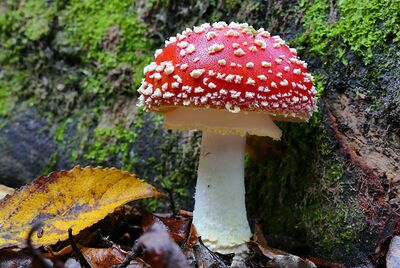
Amanita muscaria, also known as fly agaric, is a basidiomycete fungus native to temperate and boreal regions in the Norther Hemisphere. Amanita muscaria are cosmopolitan species and associates with a variety of deciduous and coniferous trees. Easily recognizable for their iconic toadstool appearance, Amanita muscaria are poisonous and contain psychoactive constituents.
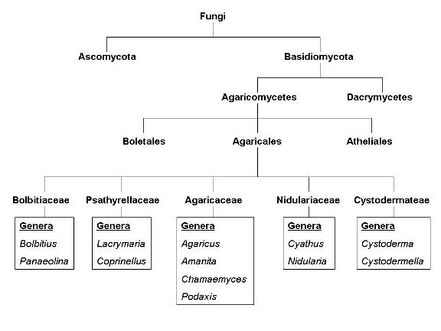
Taxonomy
Kingdom: Fungi
Phylum: Basidiomycota
Class: Agaricomycetes
Order: Agaricales
family: Amanitaceae
Overview
Amanita muscaria has many variations in regional subspecies which can be distinguished by their environment and physiology. [3]
| Image | Scientific name | Common name | Description | |
|---|---|---|---|---|
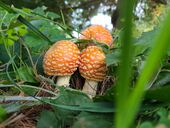 |
Amanita muscaria var. muscaria | Euro-Asian fly agaric | The muscaria variation has a bright red cap and originated from northern Europe and Asia. Cap may also be orange or yellow due to slow development of the purple pigment. | |
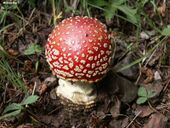 |
Amanita muscaria var. flavivolvata | American fly agaric | The flavivolvata variation is red with yellow to yellowish-white warts. It is found from southern Alaska down through Central America, all the way to Andean Colombia. | |
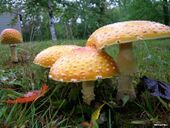 |
Amanita muscaria var. guessowii | American fly agaric (yellow variant) | The guessowii variation has a yellow to orange cap, with the center often having an orange or red gradient. | |
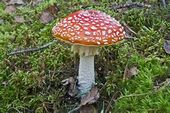 |
Amanita muscaria var. inzengae | Inzenga's fly agaric | The inzengae variation has a pale yellow to orange-yellow cap with yellowish warts and a tan stem. |
Ecology
Fly agarlic has been used historically as a pesticide by combining the mushroom with milk and spraying on plants. The practice of using amanita muscaria for pest management in Germanic and Slavic speaking parts of Europe lead to the fungus claiming the common name "fly agarlic" for its ability to kill flies.[2]
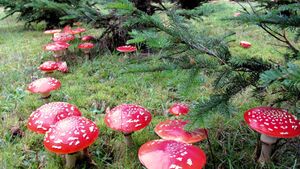
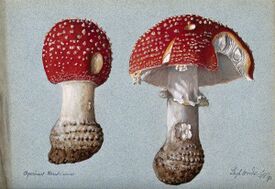
Medicinal Use
References
1. xxx
2. Wasson, R. Gordon. Soma: Divine Mushroom of Immortality. Harcourt Brace Jovanovich, 1973.
3. North Carolina State University. (n.d.). Amanita muscaria. Amanita muscaria (Fly Agaric, Fly Amanita) | North Carolina Extension Gardener Plant Toolbox. https://plants.ces.ncsu.edu/plants/amanita-muscaria/
4. xxx 5. xx 6. xxxxx